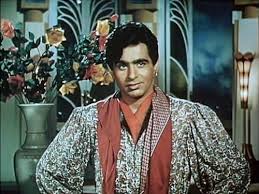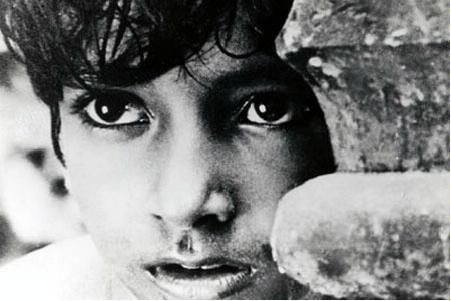Indian cinema: 1950-59
| Line 28: | Line 28: | ||
See [[examples]] and a tutorial.</div> | See [[examples]] and a tutorial.</div> | ||
|} | |} | ||
| + | ===1950=== | ||
| + | [[File:aan.jpg| Mehboob Khan's ‘Aan’ (Hindi-Urdu, 1953), was the first Indian film to be shot in the extremely expensive Technicolor.|frame|500px]] | ||
| + | 1950 : Various Film Trade Organizations confer to decide upon formation of Film Federation of India (FFI) as an apex body. Death of Rai Bahadur Chuni Lall, President of IMPAA and MPSI and one of the architects of FFI. The Pakistan Government levies a tax of Rs 1 per foot on all imported Indian films. | ||
| + | |||
| + | 1951 : FFI formed with Chandulal Shah its first president. The Film Enquiry Committee submits its report. Formation of Central Board of Film Censors with B.N. Sircar representing the Film Industry. Russian director Pudovkin and actor Cherkasov visit India traveling to Bombay, Calcutta and Madras to meet Indian Film Makers. Guru Dutt makes his directorial debut with Navketan’s Baazi. The weekly newspaper Screen is set up by the Indian Express Group. | ||
| + | |||
| + | 1952 : First International Film Festival held in India traveling to Bombay, Calcutta, Delhi and Madras. Parliament passes the Cinematograph Act of 1952 replacing 1918 Act though with little changes. A film delegation lead by Chandulal Shah visits Hollywood to study its working and to meet prominent filmmakers there. Parasakti, the most famous DMK film is released. Colour Films Aan and Jhansi ki Rani are made. Filmfare claiming to be ‘first serious effort in film journalism in India’ launched. Hindi tabloid Cinema begins publication. West Pakistan bans import of Indian Films. Bombay Talkies ceases production. | ||
| + | |||
| + | |||
| + | 1953 : Aan becomes the first Technicolor Indian film It was directed by Mehboob Khan. | ||
| + | Censorship rules amended for re-certification of films every five years and for depositing a copy of the script or film with the Censor Board. Prabhat Studio ceases production. The Cinematograph Act is amended extending the power of various authorities to suspend exhibition of certified films. The Film Federation of India accepts an Advertising Code. The Trade Weekly Trade Guide is started. Maiden Filmfare Awards are inaugurated. | ||
| + | |||
| + | 1954 : P.K. Atre’s Marathi Film Shyamchi Aayee bags the first President’s Gold Medal as the Best feature Film of 1953. Bimal Roy’s Do Bigha Zameen also made in 1953 gets special mention at Cannes. Indian Film Festival held in the Soviet Union. Awaara (1951) is a major hit in the USSR. Government publishes its decision on the S.K. Patil Enquiry Committee Recommendations. K.A. Abbas’s film Munna is the second songless film. Talks between the Film Federation of India and the Government fail over All-India Radio’s policy of broadcasting film songs without crediting sources, driving producers to Radio Ceylon. The compulsory exhibition of ‘approved’ films (Government propaganda films) in Madras is declared unlawful by the Supreme Court. Last ditch effort to save Bombay Talkies - Badbaan fails. Death of Baburao Painter. | ||
| + | [[File:pather panchali.jpg|Satyajit Ray's epochal Pather Panchali|frame|500px]] | ||
| + | |||
| + | 1955 : Pather Panchali directed by Satyajit Ray has its world premier at Museum of Modern Art, New York. Sangeet Natak Akademi organizes film seminar in Delhi at which prominent film personalities participate. Festivals of Indian Cinema in Beijing and London. The Children’s Film Society is set up. The South Indian Film Chamber of Commerce starts The Journal of the Film Chamber. The High Court at Andhra Pradesh grants an interim stay on the law of compulsory exhibition of ‘approved’ films and on the show tax. | ||
| + | |||
| + | 1956 : Pather Panchali wins President’s Gold Medal as Best Film of 1955. It also wins an award at Cannes as Best Human Document. Silver Jubilee of the Indian Talkie (1931-56) celebrated in Bombay. The Government refuses to make its ‘approved’ compulsory propaganda films available free of charge to exhibitors. The freeze on construction of new cinemas in Bombay is lifted. The Kerala Film Chamber is started in Cochin. The Andhra Film Journal is launched in Vijaywada. Hindi journal Film Sangeet published. Rossellini starts work on India 57. Despite major Government support and funds, his visa is allowed to expire after a variety of controversies including allegations that he infringed local moral codes. | ||
| + | |||
| + | 1957 : Satyajit Ray’s Aparajito (1956) wins the Golden Lion at Venice Film Festival. K.A. Abbas makes the first Indo-Soviet co-production Pardesi. RK Films’ Jagte Raho wins Grand Prix at the Karlovy Vary Festival. Kabuliwala receives a special mention for music in Berlin. Raw stock is declared an essential commodity and its import is centrally controlled. The Cinematograph Bill intended to start a National Film Board, Production Bureau and Film Institute is withdrawn. Chidananda Das Gupta, Satyajit Ray and others start the Indian Film Quarterly. | ||
| + | |||
| + | 1958 : Mother India wins an Oscar nomination for Best Foreign Film and loses to Fellini’s Nights of Caberia by a solitary vote. Nargis wins Best Actress for the film at Karlovy Vary Festival. Do Aankhen Barah Haath wins the President’s Gold Medal for Best Feature of 1957. It also wins a Silver Bear at Berlin and the Samuel Goldwyn Award for Best foreign film. Ajantrik is shown in Cannes, out of competition. Death of D.N. Sampath, founder of Kohinoor Talkies. | ||
| + | |||
| + | 1959 : Pather Panchali runs for over seven months at the Fifth Avenue Playhouse, New York and sets a record for foreign films released in the United States. Federation of Film Societies formed with Satyajit Ray as President. India’s second film in cinemascope, Kaagaz ke Phool.[[CinemaScope and 70mm films]] | ||
| + | |||
[[Category:India|C]] | [[Category:India|C]] | ||
[[Category:Cinema-Tv-Pop|C]] | [[Category:Cinema-Tv-Pop|C]] | ||
[[Category:History|C]] | [[Category:History|C]] | ||
Revision as of 09:58, 23 March 2013
Indian cinema: 1950-59
Title and authorship of the original article(s)
|
Brief history of Indian cinema By UrooJ, aligarians.com, mid-2000 |
Bollywood Cinema By h2g2, mid-2000 |
This is an article selected for the excellence of its content. |
1950
1950 : Various Film Trade Organizations confer to decide upon formation of Film Federation of India (FFI) as an apex body. Death of Rai Bahadur Chuni Lall, President of IMPAA and MPSI and one of the architects of FFI. The Pakistan Government levies a tax of Rs 1 per foot on all imported Indian films.
1951 : FFI formed with Chandulal Shah its first president. The Film Enquiry Committee submits its report. Formation of Central Board of Film Censors with B.N. Sircar representing the Film Industry. Russian director Pudovkin and actor Cherkasov visit India traveling to Bombay, Calcutta and Madras to meet Indian Film Makers. Guru Dutt makes his directorial debut with Navketan’s Baazi. The weekly newspaper Screen is set up by the Indian Express Group.
1952 : First International Film Festival held in India traveling to Bombay, Calcutta, Delhi and Madras. Parliament passes the Cinematograph Act of 1952 replacing 1918 Act though with little changes. A film delegation lead by Chandulal Shah visits Hollywood to study its working and to meet prominent filmmakers there. Parasakti, the most famous DMK film is released. Colour Films Aan and Jhansi ki Rani are made. Filmfare claiming to be ‘first serious effort in film journalism in India’ launched. Hindi tabloid Cinema begins publication. West Pakistan bans import of Indian Films. Bombay Talkies ceases production.
1953 : Aan becomes the first Technicolor Indian film It was directed by Mehboob Khan.
Censorship rules amended for re-certification of films every five years and for depositing a copy of the script or film with the Censor Board. Prabhat Studio ceases production. The Cinematograph Act is amended extending the power of various authorities to suspend exhibition of certified films. The Film Federation of India accepts an Advertising Code. The Trade Weekly Trade Guide is started. Maiden Filmfare Awards are inaugurated.
1954 : P.K. Atre’s Marathi Film Shyamchi Aayee bags the first President’s Gold Medal as the Best feature Film of 1953. Bimal Roy’s Do Bigha Zameen also made in 1953 gets special mention at Cannes. Indian Film Festival held in the Soviet Union. Awaara (1951) is a major hit in the USSR. Government publishes its decision on the S.K. Patil Enquiry Committee Recommendations. K.A. Abbas’s film Munna is the second songless film. Talks between the Film Federation of India and the Government fail over All-India Radio’s policy of broadcasting film songs without crediting sources, driving producers to Radio Ceylon. The compulsory exhibition of ‘approved’ films (Government propaganda films) in Madras is declared unlawful by the Supreme Court. Last ditch effort to save Bombay Talkies - Badbaan fails. Death of Baburao Painter.
1955 : Pather Panchali directed by Satyajit Ray has its world premier at Museum of Modern Art, New York. Sangeet Natak Akademi organizes film seminar in Delhi at which prominent film personalities participate. Festivals of Indian Cinema in Beijing and London. The Children’s Film Society is set up. The South Indian Film Chamber of Commerce starts The Journal of the Film Chamber. The High Court at Andhra Pradesh grants an interim stay on the law of compulsory exhibition of ‘approved’ films and on the show tax.
1956 : Pather Panchali wins President’s Gold Medal as Best Film of 1955. It also wins an award at Cannes as Best Human Document. Silver Jubilee of the Indian Talkie (1931-56) celebrated in Bombay. The Government refuses to make its ‘approved’ compulsory propaganda films available free of charge to exhibitors. The freeze on construction of new cinemas in Bombay is lifted. The Kerala Film Chamber is started in Cochin. The Andhra Film Journal is launched in Vijaywada. Hindi journal Film Sangeet published. Rossellini starts work on India 57. Despite major Government support and funds, his visa is allowed to expire after a variety of controversies including allegations that he infringed local moral codes.
1957 : Satyajit Ray’s Aparajito (1956) wins the Golden Lion at Venice Film Festival. K.A. Abbas makes the first Indo-Soviet co-production Pardesi. RK Films’ Jagte Raho wins Grand Prix at the Karlovy Vary Festival. Kabuliwala receives a special mention for music in Berlin. Raw stock is declared an essential commodity and its import is centrally controlled. The Cinematograph Bill intended to start a National Film Board, Production Bureau and Film Institute is withdrawn. Chidananda Das Gupta, Satyajit Ray and others start the Indian Film Quarterly.
1958 : Mother India wins an Oscar nomination for Best Foreign Film and loses to Fellini’s Nights of Caberia by a solitary vote. Nargis wins Best Actress for the film at Karlovy Vary Festival. Do Aankhen Barah Haath wins the President’s Gold Medal for Best Feature of 1957. It also wins a Silver Bear at Berlin and the Samuel Goldwyn Award for Best foreign film. Ajantrik is shown in Cannes, out of competition. Death of D.N. Sampath, founder of Kohinoor Talkies.
1959 : Pather Panchali runs for over seven months at the Fifth Avenue Playhouse, New York and sets a record for foreign films released in the United States. Federation of Film Societies formed with Satyajit Ray as President. India’s second film in cinemascope, Kaagaz ke Phool.CinemaScope and 70mm films
